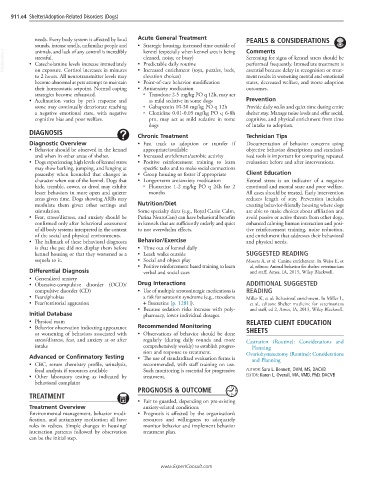Page 1822 - Cote clinical veterinary advisor dogs and cats 4th
P. 1822
911.e4 Shelter/Adoption-Related Disorders (Dogs)
needs. Every body system is affected by loud Acute General Treatment PEARLS & CONSIDERATIONS
sounds, intense smells, unfamiliar people and • Strategic housing; increased time outside of Comments
VetBooks.ir • Catecholamine levels increase immediately • Predictable daily routine Screening for signs of kennel stress should be
kennel (especially when kennel area is being
animals, and lack of any control is incredibly
stressful.
cleaned, noisy, or busy)
performed frequently. Immediate treatment is
on exposure. Cortisol increases in minutes
to 2 hours. All neurotransmitter levels may • Increased enrichment (toys, puzzles, beds, essential because delay in recognition or treat-
ment results in worsening mental and emotional
elevation choices)
become abnormal as pets attempt to maintain • Point-of-care behavior modification states, decreased welfare, and worse adoption
their homeostatic setpoint. Normal coping • Antianxiety medication outcomes.
strategies become exhausted. ○ Trazodone 2-5 mg/kg PO q 12h, may act
• Acclimation varies by pet’s response and as mild sedative in some dogs Prevention
some may continually deteriorate reaching ○ Gabapentin 10-30 mg/kg PO q 12h Provide daily walks and quiet time during entire
a negative emotional state, with negative ○ Clonidine 0.01-0.05 mg/kg PO q 6-8h shelter stay. Manage noise levels and offer social,
cognitive bias and poor welfare. prn, may act as mild sedative in some cognitive, and physical enrichment from time
dogs of intake to adoption.
DIAGNOSIS
Chronic Treatment Technician Tips
Diagnostic Overview • Fast track to adoption or transfer if Documentation of behavior concerns using
• Behavior should be observed in the kennel appropriate/available objective behavior descriptions and standard-
and when in other areas of shelter. • Increased enrichment/aerobic activity ized tools is important for comparing repeated
• Dogs experiencing high levels of kennel stress • Positive reinforcement training to learn evaluation before and after interventions.
may show barking, jumping, and lunging at specific tasks and to make social connections
passersby when kenneled that changes in • Group housing or foster if appropriate Client Education
character when out of the kennel. Dogs that • Longer-term antianxiety medication Kennel stress is an indicator of a negative
hide, tremble, cower, or drool may exhibit ○ Fluoxetine 1-2 mg/kg PO q 24h for 2 emotional and mental state and poor welfare.
lesser behaviors in more open and quieter months All cases should be treated. Early intervention
areas given time. Dogs showing ARBs may reduces length of stay. Prevention includes
modulate them given other settings and Nutrition/Diet creating behavior-friendly housing where dogs
stimulation. Some specialty diets (e.g., Royal Canin Calm, are able to make choices about affiliation and
• Fear, stress/distress, and anxiety should be Purina NeuroCare) can have behavioral benefits avoid passive or active threats from other dogs,
confirmed only after behavioral assessment in kennels that are sufficiently orderly and quiet enhanced calming human interaction and posi-
of all body systems interpreted in the context to not overwhelm effects. tive reinforcement training, noise reduction,
of the social and physical environments. and enrichment that addresses their behavioral
• The hallmark of these behavioral diagnoses Behavior/Exercise and physical needs.
is that the pet did not display them before • Time out of kennel daily
kennel housing or that they worsened as a • Leash walks outside SUGGESTED READING
sequela to it. • Social and object play Moesta A, et al: Canine enrichment. In Weiss E, et
• Positive reinforcement based training to learn al, editors: Animal behavior for shelter veterinarians
Differential Diagnosis verbal and social cues and staff, Ames, IA, 2015, Wiley Blackwell.
• Generalized anxiety
• Obsessive-compulsive disorder (OCD)/ Drug Interactions ADDITIONAL SUGGESTED
compulsive disorder (CD) • Use of multiple serotoninergic medications is READING
• Fears/phobias a risk for serotonin syndrome (e.g., trazodone Miller K, et al: Behavioral enrichment. In Miller L,
• Fear/territorial aggression + fluoxetine [p. 1281]). et al, editors: Shelter medicine for veterinarians
• Because sedation risks increase with poly- and staff, ed 2, Ames, IA, 2013, Wiley Blackwell.
Initial Database pharmacy, lower individual dosages.
• Physical exam RELATED CLIENT EDUCATION
• Behavior observation indicating appearance Recommended Monitoring SHEETS
or worsening of behaviors associated with • Observations of behavior should be done
stress/distress, fear, and anxiety at or after regularly (during daily rounds and more Castration (Routine): Considerations and
intake comprehensively weekly) to establish progres- Planning
sion and response to treatment. Ovariohysterectomy (Routine): Considerations
Advanced or Confirmatory Testing • The use of standardized evaluation forms is and Planning
• CBC, serum chemistry profile, urinalysis, recommended, with staff training on use.
fecal analysis if resources available Such monitoring is essential for progressive AUTHOR: Sara L. Bennett, DVM, MS, DACVB
• Other laboratory testing as indicated by treatment. EDITOR: Karen L. Overall, MA, VMD, PhD, DACVB
behavioral complaint
PROGNOSIS & OUTCOME
TREATMENT
• Fair to guarded, depending on pre-existing
Treatment Overview anxiety-related conditions
Environmental management, behavior modi- • Prognosis is affected by the organization’s
fication, and antianxiety medication all have resources and willingness to adequately
roles in redress. Simple changes in housing/ monitor behavior and implement behavior
interaction patterns followed by observation treatment plan.
can be the initial step.
www.ExpertConsult.com

